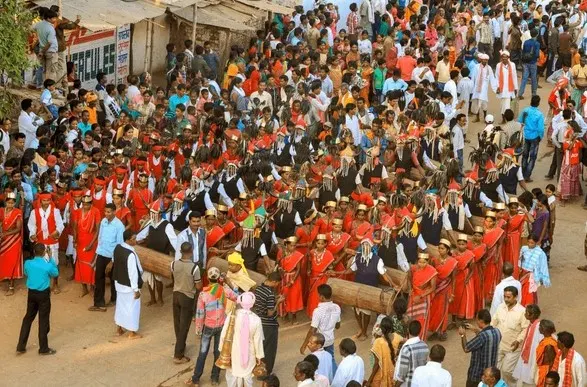1 May Maharashtra Day
https://bharatpractice.blogspot.com/2024/04/mughal-empire-family-tree.html
History and Importance of Maharashtra Day.
Before 1960, the region that now constitutes Maharashtra was part of the Bombay State, which included present-day Maharashtra, Gujarat, and parts of present-day Karnataka. However, there was a strong demand for a separate Marathi-speaking state, and as a result of the States Reorganization Act of 1956, Bombay State was divided along linguistic lines.
On May 1st, 1960, the Marathi-speaking regions of Bombay State were separated to form the new state of Maharashtra, with Mumbai (then Bombay) as its capital. The newly formed state of Maharashtra also included Vidarbha and Marathwada regions, which were part of the former Hyderabad State and Central Provinces and Berar.
Maharashtra Day is celebrated annually to honor the establishment of the state and to commemorate the linguistic and cultural identity of the Marathi-speaking people. It is a day of pride and celebration for the people of Maharashtra, marked by various cultural events, parades, and flag-hoisting ceremonies across the state.
The day serves as a reminder of the struggles and sacrifices made by leaders and activists who advocated for the creation of a separate Marathi-speaking state. It reflects the aspirations of the people of Maharashtra for self-governance and cultural preservation.
Maharashtra Day is celebrated with great fervor and pride across the state, with various cultural events, parades, and flag-hoisting ceremonies. It provides an opportunity for people to express their love for their state and reaffirm their commitment to its development and prosperity.
Furthermore, Maharashtra Day also serves as a platform to showcase the rich cultural heritage, traditions, and achievements of the state. It fosters a sense of unity and solidarity among the people of Maharashtra, transcending regional and linguistic differences.
https://bharatpractice.blogspot.com/2024/03/what-is-akhand-bharat.html
Key Facts of Maharashtra
Capital: Mumbai is the capital city of Maharashtra, serving as the financial, commercial, and entertainment capital of India.
Formation: Maharashtra was formed on May 1, 1960, following the reorganization of states based on linguistic lines. It was created by merging the Marathi-speaking regions of the former Bombay State with the princely states of Maharashtra and Vidarbha.
Geography: Maharashtra is located in the western region of India and is the third-largest state by area. It shares borders with the Arabian Sea to the west, Gujarat and Madhya Pradesh to the north, Chhattisgarh to the east, Telangana to the southeast, Karnataka to the south, and Goa to the southwest.
Population: With over 112 million people, Maharashtra is the second-most populous state in India, after Uttar Pradesh.
Language and Culture: Marathi is the official language of Maharashtra and is widely spoken by the majority of the population. The state has a rich cultural heritage, with vibrant traditions, festivals, music, dance forms like Lavani and Tamasha, and cuisine.
Economy: Maharashtra has a diverse economy, contributing significantly to India's GDP. Mumbai, the financial hub, is home to the Bombay Stock Exchange (BSE) and the Reserve Bank of India (RBI). The state is also known for its industries, including manufacturing, agriculture, textiles, IT, and entertainment.
Tourist Attractions: Maharashtra boasts several tourist destinations, including historic sites like the Ajanta and Ellora Caves, Elephanta Caves, and forts like Raigad and Shivneri. It is also famous for its hill stations like Mahabaleshwar and Matheran, beaches in Alibaug and Ganpatipule, and wildlife sanctuaries like Tadoba and Pench.
Political Landscape: Maharashtra has a bicameral legislature, consisting of the Maharashtra Legislative Assembly and Maharashtra Legislative Council. The state is governed by the Chief Minister, who is the head of government, and the Governor, who represents the President of India.
Education: Maharashtra is home to several prestigious educational institutions, including the University of Mumbai, Savitribai Phule Pune University, Indian Institute of Technology Bombay (IIT Bombay), and Tata Institute of Social Sciences (TISS).
Transportation: The state has a well-developed transportation infrastructure, with extensive road, rail, and air connectivity.
Mumbai's Chhatrapati Shivaji Maharaj International Airport ranks among the busiest airports in India.Industry: Maharashtra is a leading industrial state, with major industrial hubs in Mumbai, Pune, Nashik, Aurangabad, and Nagpur. It is known for industries such as textiles, automobiles, pharmaceuticals, information technology, and manufacturing.
Agriculture: Agriculture is an important sector in Maharashtra, with crops like sugarcane, cotton, soybeans, and fruits being cultivated. The state also leads in the production of grapes and mangoes.
Politics: Maharashtra has a dynamic political landscape, with major political parties like the Shiv Sena, Bharatiya Janata Party (BJP), Indian National Congress (INC), and Nationalist Congress Party (NCP) having significant influence.
Literature and Arts: Maharashtra has a rich literary and artistic heritage, with renowned personalities like Jyotirao Phule, B. R. Ambedkar, and V. S. Khandekar contributing to literature and social reform movements.
Religion: Maharashtra is home to diverse religious communities, with Hinduism being the majority religion. The state also has significant populations of Muslims, Buddhists, Christians, Jains, and Sikhs.
Festivals: Maharashtra celebrates a variety of festivals throughout the year, including Ganesh Chaturthi, Diwali, Gudi Padwa (Marathi New Year), and Makar Sankranti. These festivals reflect the cultural vibrancy and diversity of the state.
Frequently Ask Questions
What is Maharashtra Day?
Why is Maharashtra Day celebrated?
How is Maharashtra Day celebrated?
What is the significance of Maharashtra Day?
Is Maharashtra Day a public holiday?

